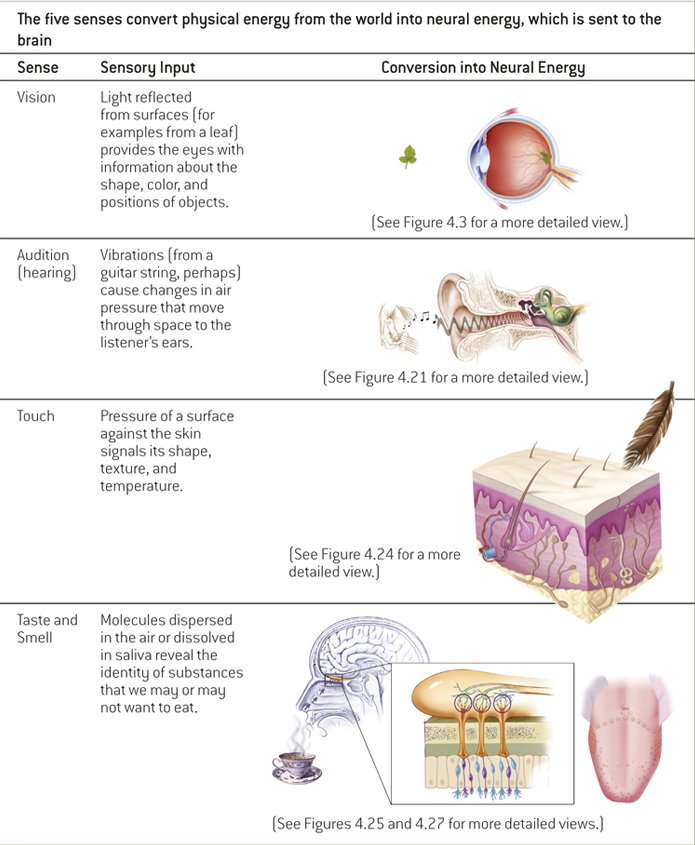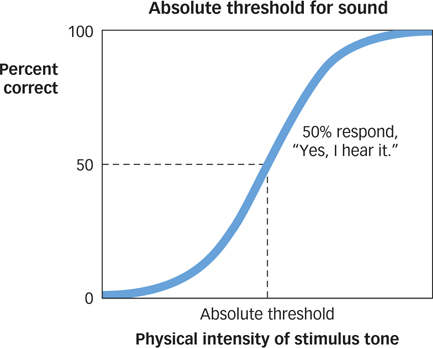4.1 Sensation and Perception Are Distinct Activities
Sensation is simple stimulation of a sense organ. It is the basic registration of light, sound, pressure, odor, or taste as parts of your body interact with the physical world. After a sensation registers in your central nervous system, perception takes place in your brain: the organization, identification, and interpretation of a sensation in order to form a mental representation. Sensation and perception are related—
sensation
Simple stimulation of a sense organ.
perception
The organization, identification, and interpretation of a sensation in order to form a mental representation.
As an example, your eyes are coursing across these sentences right now. The sensory receptors in your eyeballs are registering different patterns of light reflecting off the page. Your brain is integrating and processing that light information into the meaningful perception of words. Your eyes—
What role does the brain play in what we see and hear?
Sensory receptors communicate with the brain through transduction, which occurs when many sensors in the body convert physical signals from the environment into encoded neural signals sent to the central nervous system. In vision, light reflected from surfaces provides the eyes with information about the shape, color, and position of objects. In audition, vibrations (from vocal cords or a guitar string, perhaps) cause changes in air pressure that propagate through space to a listener’s ears. In touch, the pressure of a surface against the skin signals its shape, texture, and temperature. In taste and smell, molecules dispersed in the air or dissolved in saliva reveal the identity of substances that we may or may not want to eat. In each case, physical energy from the world is converted to neural energy inside the central nervous system (see TABLE 4.1).
transduction
What takes place when many sensors in the body convert physical signals from the environment into encoded neural signals sent to the central nervous system.
Table 4.1Transduction

Psychophysics
Knowing that perception takes place in the brain, you might wonder if two people see the same colors in the sunset when looking at the evening sky. It’s intriguing to consider the possibility that our basic perceptions of sights or sounds might differ fundamentally from those of other people. How can we measure such a thing objectively? Measuring the physical energy of a stimulus, such as the wavelength of a light, is easy enough: You can probably buy the necessary instruments online to do that yourself. But how do you quantify a person’s private, subjective perception of that light?
97
Why isn’t it enough for a psychophysicist to measure only the strength of a stimulus?
In the mid-
psychophysics
Methods that measure the strength of a stimulus and the observer’s sensitivity to that stimulus.

98
Measuring Thresholds
Psychophysicists begin the measurement process with a single sensory signal to determine precisely how much physical energy is required for an observer to become aware of a sensation. The simplest quantitative measurement in psychophysics is the absolute threshold, the minimal intensity needed to just barely detect a stimulus in 50% of the trials. A threshold is a boundary. The doorway that separates the inside from the outside of a house is a threshold, as is the boundary between two psychological states (awareness and unawareness, for example). In finding the absolute threshold for sensation, the two states in question are sensing and not sensing some stimulus. TABLE 4.2 lists the approximate sensory thresholds for each of the five senses.
absolute threshold
The minimal intensity needed to just barely detect a stimulus in 50% of the trials.
Table 4.2Approximate Sensory Thresholds


To measure the absolute threshold for detecting a sound, for example, an observer sits in a soundproof room wearing headphones linked to a computer. The experimenter presents a pure tone (the sort of sound made by striking a tuning fork) using the computer to vary the loudness or the length of time each tone lasts and recording how often the observer reports hearing that tone under each condition. The outcome of such an experiment is graphed in FIGURE 4.1. Notice from the shape of the curve that the transition from not hearing to hearing is gradual rather than abrupt.
If we repeat this experiment for many different tones, we can observe and record the thresholds for tones ranging from very low to very high pitch. It turns out that people tend to be most sensitive to the range of tones corresponding to human conversation. If the tone is low enough, such as the lowest note on a pipe organ, most humans cannot hear it at all; we can only feel it. If the tone is high enough, we likewise cannot hear it, but dogs and many other animals can.
The absolute threshold is useful for assessing how sensitive we are to faint stimuli, but the human perceptual system is better at detecting changes in stimulation than the simple onset or offset of stimulation. When parents hear their infant’s cry, it’s useful to be able to differentiate the “I’m hungry” cry from the “I’m cranky” cry from the “something is biting my toes” cry. The just noticeable difference (JND) is the minimal change in a stimulus that can just barely be detected.
just noticeable difference (JND)
The minimal change in a stimulus that can just barely be detected.
What is the importance of proportion to the measurement of just noticeable difference?
The JND is not a fixed quantity; rather, it is roughly proportional to the intensity of the stimulus. This relationship was first noticed in 1834 by German physiologist Ernst Weber (Watson, 1978) and is now called Weber’s law: The just noticeable difference of a stimulus is a constant proportion despite variations in intensity. As an example, if you picked up a 1-
Weber’s law
The just noticeable difference of a stimulus is a constant proportion despite variations in intensity.
99
Signal Detection
Measuring absolute and difference thresholds requires a critical assumption: that a threshold exists! But humans don’t suddenly and rapidly switch between perceiving and not perceiving; in fact, the very same physical stimulus, such as a dim light or a quiet tone, presented on several different occasions, may be perceived by the same person on some occasions but not on others (see FIGURE 4.1). Remember, an absolute threshold is operationalized as perceiving the stimulus 50% of the time, which means the other 50% of the time it might go undetected.
Our accurate perception of a sensory stimulus, then, can be somewhat haphazard. Whether in the psychophysics lab or out in the world, sensory signals face a lot of competition, or noise, which refers to all the other stimuli coming from the internal and external environment. Memories, moods, and motives intertwine with what you are seeing, hearing, and smelling at any given time. This internal “noise” competes with your ability to detect a stimulus with perfect, focused attention. Other sights, sounds, and smells in the world at large also compete for attention. As a consequence, you may not perceive everything that you sense, and you may even perceive things that you haven’t sensed.
How accurate and complete are our perceptions of the world?
An approach to psychophysics called signal detection theory holds that the response to a stimulus depends both on a person’s sensitivity to the stimulus in the presence of noise and on a person’s decision criterion. That is, observers consider the sensory evidence evoked by the stimulus and compare it to an internal decision criterion (Green & Swets, 1966; Macmillan & Creelman, 2005). If the sensory evidence exceeds the criterion, the observer responds by saying, “Yes, I detected the stimulus,” and if it falls short of the criterion, the observer responds by saying, “No, I did not detect the stimulus.”
signal detection theory
The response to a stimulus depends both on a person’s sensitivity to the stimulus in the presence of noise and on a person’s response criterion.

Signal detection theory has practical applications at home, school, work, and even while driving. For example, a radiologist may have to decide whether a mammogram shows that a woman has breast cancer. The radiologist knows that certain features, such as a mass of a particular size and shape, are associated with the presence of cancer. But noncancerous features can have an appearance that is very similar to cancerous ones. The radiologist may decide on a strictly liberal criterion and check every possible case of cancer with a biopsy. This decision strategy minimizes the possibility of missing a true cancer but leads to many unnecessary biopsies. A strictly conservative criterion will cut down on unnecessary biopsies but will miss some treatable cancers. These different types of errors have to be weighed against one another in setting the decision criterion. For an example of a common everyday task that can interfere with signal detection, see the Real World box.
100
The Real World: Multitasking
Multitasking
By one estimate, using a cell phone while driving makes having an accident four times more likely (McEvoy et al., 2005). In response to statistics such as this, state legislatures are passing laws that restrict—

Talking on a cell phone while driving demands that you juggle two independent sources of sensory input—
Whether the phone was handheld or hands-
So how well do you multitask in several thousand pounds of metal hurtling down the highway? Unless you have two heads with one brain each—
Sensory Adaptation
When you walk into a bakery, the aroma of freshly baked bread overwhelms you, but after a few minutes, the smell fades. If you dive into cold water, the temperature is shocking at first, but after a few minutes, you get used to it. When you wake up in the middle of the night for a drink of water, the bathroom light blinds you, but after a few minutes, you no longer squint. These are all examples of sensory adaptation: Sensitivity to prolonged stimulation tends to decline over time as an organism adapts to current conditions.
sensory adaptation
Sensitivity to prolonged stimulation tends to decline over time as an organism adapts to current conditions.
What conditions have you already adapted to today? Sounds? Smells?
Sensory adaptation is a useful process for most organisms. Imagine what your sensory and perceptual world would be like without it. (If you had to be constantly aware of how your tongue feels while it is resting in your mouth, you’d be driven to distraction.) Our sensory systems respond more strongly to changes in stimulation than to constant stimulation. A stimulus that doesn’t change usually doesn’t require any action; your car probably emits a certain hum all the time, one that you’ve gotten used to. But a change in stimulation often signals a need for action. If your car starts making different kinds of noises, you’re not only more likely to notice them, but you’re also more likely to do something about it.
visual acuity
The ability to see fine detail.

101
SUMMARY QUIZ [4.1]
Question 4.1
| 1. | Sensation involves _____________, whereas perception involves _____________. |
- organization; coordination
- stimulation; interpretation
- identification; translation
- comprehension; information
b.
Question 4.2
| 2. | What process converts physical signals from the environment into neural signals carried by sensory neurons into the central nervous system? |
- representation
- identification
- propagation
- transduction
d.
Question 4.3
| 3. | The smallest intensity needed to just barely detect a stimulus is called |
- proportional magnitude.
- absolute threshold.
- just noticeable difference.
- Weber’s law.
b.